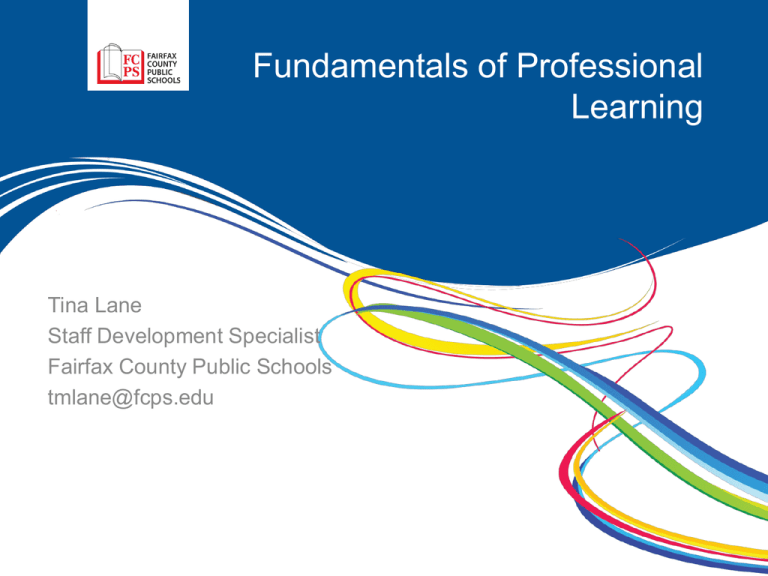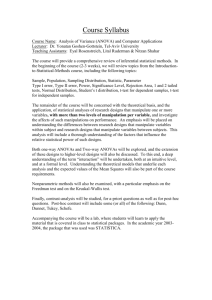
Fundamentals of Professional
Learning
Tina Lane
Staff Development Specialist
Fairfax County Public Schools
tmlane@fcps.edu
Four Corners
• Go to the corner of your choice.
• Talk with one or two people (no more
than 3) about why you chose the corner.
2
Four Corners
• Complete the prompt with your partners.
• ___________ is like professional
development because…
3
Like Me
Objectives
• Develop an understanding of the
standards and determine how to use the
standards to improve the quality and
results of professional learning.
• Discover strategies for engaging adult
learners.
• Introduce a variety of designs for
professional learning and consider when
to use each one.
• Reflect on how to use these practices in
your work.
Agenda
•
•
•
•
•
•
•
Welcome
Standards for Professional Learning
Audience Types
Strategies for Professional Learning
Adult Learning
Learning Designs
Organizing and Integrating
Line Up
Essential Questions
• What are the standards?
• How can the standards
improve the quality and
effectiveness of professional
learning?
9
Link Professional Learning to
Student Results
1. Standardsbased
professional
learning
2. Changes in
educator
knowledge, skills,
and dispositions
4. Changes in
student
results
3. Changes in
educator
practice
10
10
Standards Jigsaw
Home Group
1. Read and highlight the
information about your
standard. (pgs. 2-10)
11
11
Standards Jigsaw
Expert Group
1. Join the other people with
your standard.
2. Prepare a “windowpane” for
your standard. (pg. 11)
12
12
WINDOWPANE FOR STANDARD:
_______________
Key Points
Standards in Practice
Symbol
Next Steps
13
Standards Jigsaw
Home Team
3. Share your group’s
windowpane.
4. Take notes on each
standard. (pg. 12)
14
14
How to Use the Standards
• To stimulate dialogue, discussion,
and analysis that lead to increased
effectiveness in professional
learning.
• To benchmark existing opportunities
for professional learning against the
standards to identify strengths and
areas for improvement.
• To set policies.
15
15
Standards for Professional
Learning
What do you want to be sure to
hold onto about the standards?
16
16
The Four Audience Types
4 Questions
• Decide on your favorite question:
–
–
–
–
What?
So What?
Why?
What if?
• Move to the poster that corresponds to your question
• Read & Talk about the preferences of your type
• Create a visual to help us understand your audience
type
The Four Audience Types
• Professors
• Friends
• Scientists
• Inventors
Four Audience Types
Audience
Type
Considerations
Scientist
Want to know why content is important.
Intellectually satisfied with data and graphs.
Professor Want to know what is important AND how to
remember the content/skills taught. Often
respond well to citations, feedback, and practice
Inventor
Want to know what to do next with information.
Are creative, like to explore new ideas, and
express new learning
Friend
Want involvement and engagement with others in
room. Often respond well to stories and group
activities
Silver, Strong, and Petini (2008) The Strategic Teacher:20
Selecting the Right Research-Based Strategy for Every
The Four Audience Types
• Think about an upcoming
professional development.
How might you use this
information to plan your session?
Lunch
• We will begin again at 2:15
M. I. P.
• What is your Most Important Point from
this morning?
• Share with an eye contact partner.
Strategies
• Think about an upcoming
professional development. Choose
an opening activity, engaging activity,
and summarizing activity you
will use.
Adult Learning
27
27
First Turn/ Last Turn
• Individually read and highlight pgs. 17-23
• In turn, share one of your highlighted items,
but do not comment on it -- The First Turn
• Group members comment in round-robin
order about the item (with no cross-talk)
• The initiating person then shares his or her
thinking about the item and gets – The Last Turn
-- Repeat pattern in sequence around the table -Groups at Work – Copyright MiraVia LLC – All rights
reserved
First Turn/ Last Turn
Reflection on Process
•
How does this strategy support dialogue?
•
How might this strategy contribute to
group development?
Groups at Work – Copyright MiraVia LLC – All rights
reserved
First Turn/ Last Turn
Reflection on Content
•
How might you use the information to
develop professional development
sessions?
Groups at Work – Copyright MiraVia LLC – All rights
reserved
LEARNING DESIGNS
Read and Respond
Professional learning that
increases educator
effectiveness and results for
all students integrates theories,
research, and models of
human learning to achieve its
intended outcomes.
31
Read and Respond
“Traditionally, professional
development has had little
impact on teacher practices
and student achievement.
Professional development
usually occurred in workshops
that individual teachers
attended outside of schools…”
32
“…Now, research is emerging that
professional development that has
the highest impact focuses on
teachers’ content, occurs in their
own schools, involves all teachers
rather than developing individuals,
and is collaborative. Simply put,
collaborative professional learning
is when teachers work together to
improve teaching and learning.”
Becoming A Learning School, Killion and Roy
33
A-D Each Teach
Topic: Learning Designs
Quartets:
• Letter off A-D
A reads pp. 24-25
B reads pp. 26-28
C reads pp. 29-30
D reads pp. 31-32
• When ready, “Each Teach” your
learning designs
Groups at Work – Copyright MiraVia LLC – All rights
reserved
LEARNING DESIGNS
Scenarios
• With your quartet, work
through your assigned
scenario.
36
Designs for Your Work
• Select a professional learning goal.
• Identify possible learning designs that
will support you in achieving your goal.
• Complete the graphic organizer (pg.
35).
37
The Other Agenda
Key Words
Individually:
• Reflect on this session and select a key word
(e.g. important idea, concept, emotion)
Table Groups:
• Share your word in a round-robin pattern
( the ‘what’ and the ‘why’ )
• Choose one member to share his or her key
word with the full group
Groups at Work – Copyright MiraVia LLC – All rights
reserved
Every system
is designed
to get the
results it’s
getting.
NSDCs Standards for Staff
Development Trainer’s Guide
Stephanie Hirsh, 2001
40
The question for educators is
not whether all humans can learn,
but what conditions can we
devise so that they will learn.
Roland Barth, Learning By Heart
41
Contact Information
• Tina Lane
• tmlane@fcps.edu
• 571-423-3110







